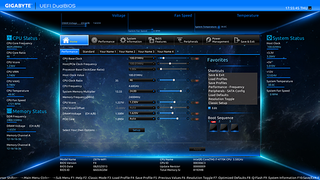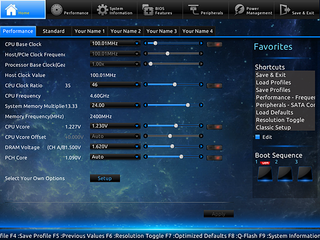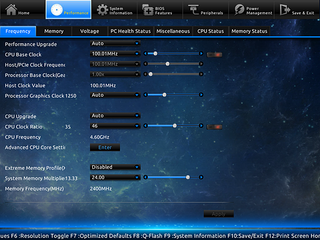Five Z87 Motherboards For Your Mini-ITX Build, Reviewed
Z87 rules the PC enthusiast market by exposing the Haswell architecture's full feature set. We're particularly interested in mini-ITX-based platforms able to integrate Z87 in a compact form factor. Five boards contend for supremacy of compact computing.
Z87N-WiFi Firmware
Gigabyte’s UEFI is optimized for 1080p displays, showing system status in various menus that surround its main settings. Fortunately, the F6 key toggles the screen to low-resolution mode, where only the main menus remain.

The user-configurable home page is set by default to provide the most common overclock settings, including base clock, multipliers, and key voltage levels.

Z87N-WiFi firmware defaults to 99.77 MHz in Auto mode, but selecting a 100.01 MHz base clock results in an actual 100.00 MHz.

The Z87N-WiFi had no difficulty reaching the 4.6 GHz we were expecting, but our XMP-3000 memory profile didn’t work. We had to drop the memory multiplier to 24 x 100 MHz.

The Z87N-WiFi memory menu has redundant multiplier and XMP settings. Switching from Auto memory timings to Manual provides combined (both channel) timing controls, while per-channel settings can be made using Advanced Manual timings.




Primary, secondary, and tertiary memory timings are all adjustable. We were able to run our RAM at DDR3-2400 CAS 9, but loosening it to slower XMP timings did not allow stability at any higher memory ratio.




The Voltage menu is a launching point for three submenus that, combined, would have still fit onto one page. We reached our desired 1.25 V CPU core voltage at the Z87N-WiFi’s 1.23 V setting, and our memory’s 1.65 V rating at the board’s 1.62 V setting.
Stay on the Cutting Edge
Join the experts who read Tom's Hardware for the inside track on enthusiast PC tech news — and have for over 25 years. We'll send breaking news and in-depth reviews of CPUs, GPUs, AI, maker hardware and more straight to your inbox.
-
PEJUman Why would one pay extra for ASUS's power delivery if it didn't yield any additional OC/DRAM stability? In the end, ASRock features & cheaper price should be a better option here.Reply -
Crashman Reply
Yes, they've sent one for another article. If the site did multiple items per manufacturer the article would take weeks to finish. That wouldn't be a problem if all Tom's Hardware did was motherboards :p12025866 said:Here is another MSI ITX board
ASRock's cheaper features also made it a competitor with the cheaper boards for the value award. Since it competed well for both awards, it had to get a different award.12025873 said:Why would one pay extra for ASUS's power delivery if it didn't yield any additional OC/DRAM stability? In the end, ASRock features & cheaper price should be a better option here.
-
nukemaster While some may not like the layout, the Gigabyte and MSI layout should work well in some cases like the SG05 from SilverStone. The top mounted power and sata ports help keep wires out of the air flow path.Reply
More room between the PCI-E and CPU LGA is nice on the Asus as are all the features.
I am still running an older H55n usb3 24/7 and it has been quite stable and cool and low on power consumption. Shame that this new gigabyte board has higher power and temperature levels. -
xkm1948 Since most of them has built in Wi-Fi. Will it be better to include a Wi-Fi test column?Reply -
Crashman Reply
We formerly had a controller reviewer, and I'd like to see someone take on this task again. A separate article on the controllers (with everything else identical) wouldn't tell you anything about the antennas included with different products, but antennas are cheaply replaceable.12025986 said:Since most of them has built in Wi-Fi. Will it be better to include a Wi-Fi test column?
-
KrazyKap Is the Asus Z87 Pro the same as the Deluxe? Seems to be region specific but I can't find the difference. Help? I've just bought the Pro for myself as it is only slightly more than the MSI or Gigabyte options.Reply -
vertexx Let's just roll some dice and toss out some awards, eh? Couldn't help but laugh through the conclusion.Reply
Overall it's good to see the roundup. Would have liked to see post times. With SSD storage, motherboard post times are now becoming the longer wait in a system boot up.
Also interested in thoughts on reasons for Z87 mobos for a standard non-overclocking build. For a non-overclocked gaming ITX PC, say with an I3 or low-end I5, are there any compelling reasons to pay the Z87 premium over, say an H81, which can run $100 cheaper? -
rolli59 Nice review and boards, conclusion is all good buy's depending on what features you want except the EVGA.Reply
Most Popular


